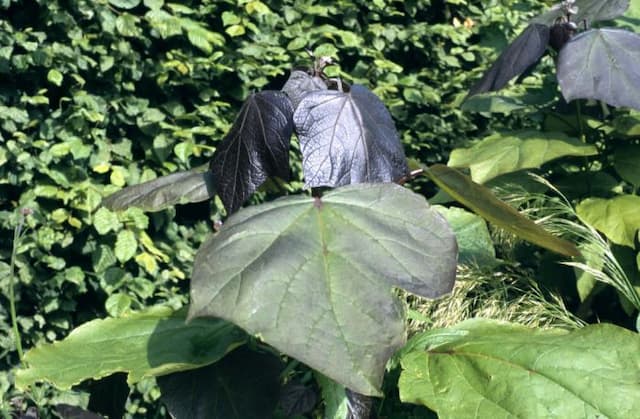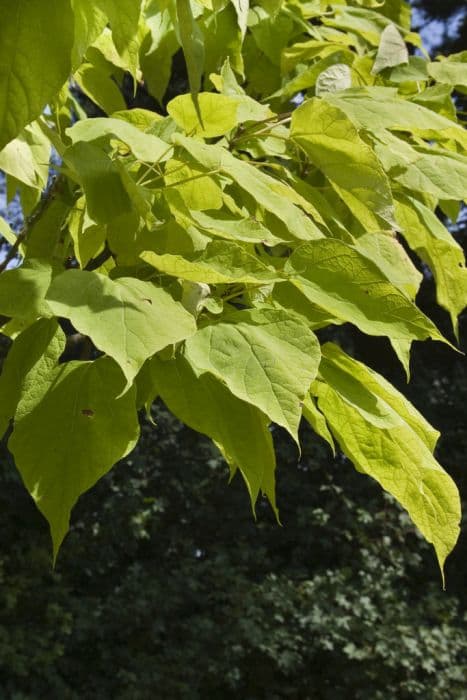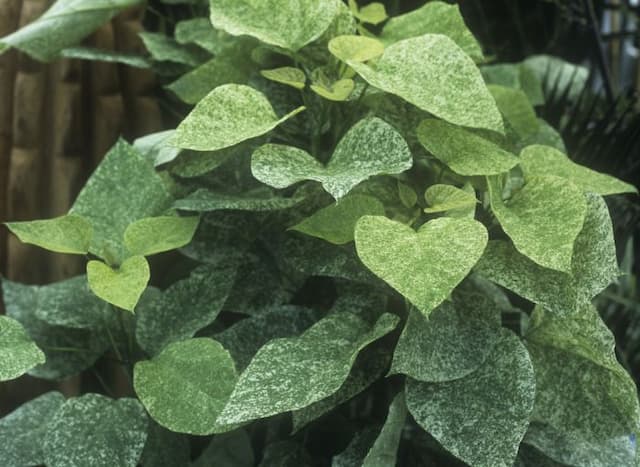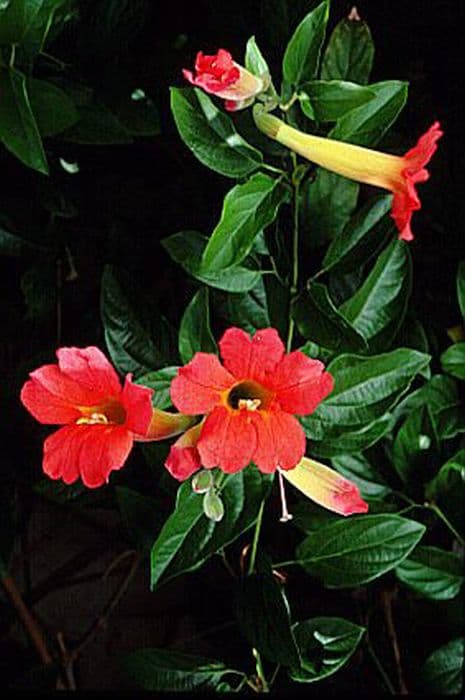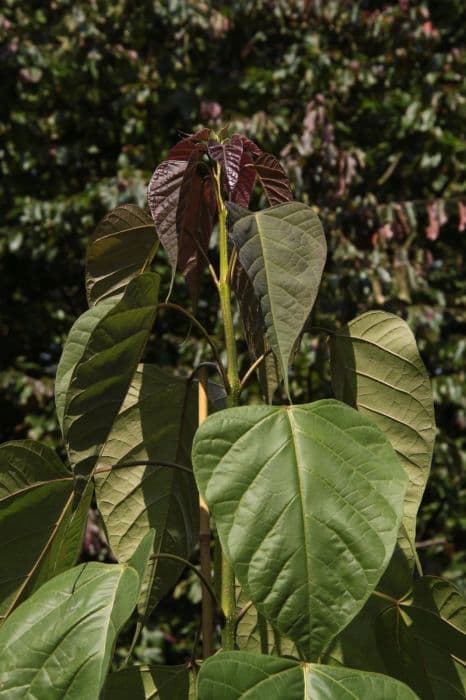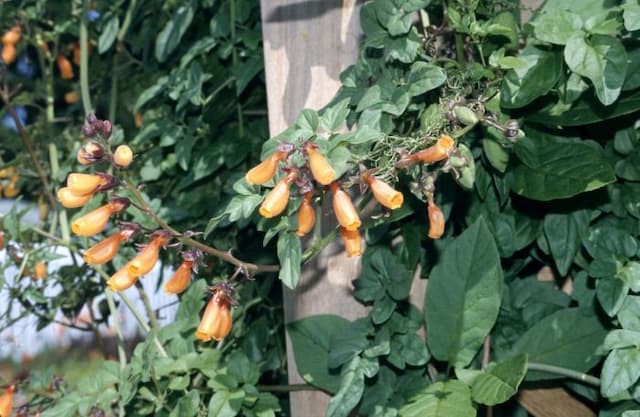Chinese Catalpa Catalpa ovata

ABOUT
The Chinese catalpa is an ornamental decidicionous tree notable for its broad, heart-shaped leaves that have a somewhat rough texture. The foliage is a vibrant green color, providing a lush, full canopy that casts dappled shade below. During the flowering season, the tree is adorned with clusters of bell-shaped flowers. These blooms are typically white and may exhibit small purple or yellow spots inside. As the seasons change, the flowers give way to long, slender seed pods that hang from the branches, resembling slender beans. The bark of the Chinese catalpa is ridged and furrowed, offering a rugged and textured appearance. The overall form of the tree tends to be irregular, with an open branching structure that gives it a distinctive silhouette in the landscape.
About this plant
 Names
NamesFamily
Bignoniaceae
Synonyms
Chinese Catalpa, Yellow Catalpa, Japanese Catalpa
Common names
Catalpa kaempferi, Catalpa henryi, Bignonia catalpa.
 Toxicity
ToxicityTo humans
The Chinese catalpa is not widely known for its toxicity to humans. However, as with many plants, it is advisable to exercise caution and not consume any parts of plants not known to be edible. If ingested, parts of the plant could potentially cause mild stomach upset due to the presence of various plant compounds. The ingestion of significant amounts of the plant might lead to more severe gastrointestinal symptoms, but generally, the Chinese catalpa is not classified as a highly toxic plant to humans.
To pets
The Chinese catalpa does not appear on the list of plants commonly known to be toxic to pets such as dogs and cats. However, the ingestion of any non-food plant material can potentially cause some level of gastrointestinal distress in pets, such as vomiting or diarrhea, simply due to it being foreign to their digestive system. If a pet has consumed a large amount of any part of a Chinese catalpa, it is best to monitor the pet's condition and consult a veterinarian if any concerning symptoms arise.
 Characteristics
CharacteristicsLife cycle
Perennials
Foliage type
Deciduous
Color of leaves
Green
Flower color
White
Height
20-30 feet (6-9 meters)
Spread
20-40 feet (6-12 meters)
Plant type
Tree
Hardiness zones
5
Native area
China
Benefits
 General Benefits
General Benefits- Shade provider: Catalpa ovata, commonly known as the Chinese catalpa, grows into a large tree that offers ample shade in landscapes and parks.
- Aesthetic appeal: With its broad heart-shaped leaves and clusters of white flowers, the Chinese catalpa is an attractive ornamental tree.
- Drought resistance: Once established, the Chinese catalpa is quite drought-tolerant, making it suitable for xeriscaping and low-water gardens.
- Wildlife habitat: The tree provides shelter and nesting sites for various bird species, enhancing biodiversity.
- Erosion control: Its root system helps stabilize soil, preventing erosion on slopes and banks.
- Urban tolerant: The Chinese catalpa adapts well to urban conditions, tolerating pollution and compacted soil.
- Wood production: The wood of Catalpa ovata is durable and resistant to rot, making it useful for outdoor furniture and construction.
 Medical Properties
Medical Properties- Anti-inflammatory: Catalpa ovata has been used in traditional medicine for its potential anti-inflammatory properties.
- Antimicrobial: Extracts from the plant may possess antimicrobial activity against certain bacteria and fungi.
- Antioxidant: The plant contains compounds that may exhibit antioxidant effects, which can help in protecting cells from oxidative stress.
- Hepatoprotective: There is some evidence to suggest that Catalpa ovata might have liver-protective effects and could be beneficial for liver health.
- Antitumor: There have been studies indicating that components in Catalpa ovata might have antitumor properties.
- Diuretic: Traditional applications of Catalpa ovata include its use as a diuretic, helping to promote the elimination of fluids from the body.
 Air-purifying Qualities
Air-purifying QualitiesThis plant is not specifically known for air purifying qualities.
 Other Uses
Other Uses- Catalpa ovata wood is often used in woodworking and carpentry for making furniture due to its durability and resistance to rot.
- The tree is sometimes planted as an ornamental due to its showy flowers and broad canopy, making for a pleasant shade tree in gardens and parks.
- Fishing enthusiasts sometimes use the long, bean-like seed pods or the tree's leaves as makeshift bait for catching catfish.
- In parts of China, the tree's leaves are used as a feed for silkworms, offering an alternative to the traditional mulberry leaves.
- The dried seed pods of Catalpa ovata can be used in floral arrangements and crafts for their unique shape and interesting texture.
- Wood from the Catalpa ovata tree is used for making musical instruments, such as some parts of drums, because of its acoustic properties.
- The fibrous inner bark of the Catalpa ovata tree can be utilized in making ropes and twines in survival situations or traditional crafts.
- During the fall, the leaves of the Catalpa ovata tree turn yellow and can be used to create natural dyes for textiles and art projects.
- The Catalpa ovata can be utilized in agroforestry practices, combining agricultural and forestry technologies to create more diverse, productive, and sustainable land-use systems.
- In some cultures, the seeds of Catalpa ovata may be strung into jewelry or decorative items, capitalizing on their unique shape and appearance.
Interesting Facts
 Feng Shui
Feng ShuiThe Chinese Catalpa is not used in Feng Shui practice.
 Zodiac Sign Compitability
Zodiac Sign CompitabilityThe Chinese Catalpa is not used in astrology practice.
 Plant Symbolism
Plant Symbolism- Resilience: The Catalpa tree, also known as Chinese catalpa, is known for its hardy nature and ability to thrive in various conditions, symbolizing the ability to withstand challenges and adversity.
- Protection: With its broad leaves that provide ample shade, the Chinese catalpa is often seen as a symbol of shelter and protection from the heat of the sun or the harshness of the environment.
- Uniqueness: The large, heart-shaped leaves and striking flowers make the Chinese catalpa stand out among other trees, symbolizing uniqueness and the beauty of standing out from the crowd.
- Prosperity and Abundance: Because the Chinese catalpa produces an abundance of flowers, it is often associated with prosperity and the bountiful aspects of nature.
 Water
WaterThe Chinese Catalpa requires moderate watering and does not tolerate waterlogged soils. It's best to water the plant deeply once a week by providing about 1-2 gallons, allowing moisture to reach the root zone. The soil should be allowed to dry out slightly between waterings. During the hot summer months, the frequency of watering may need to increase, particularly if the tree is young or recently planted. In the winter, reduce watering as the tree becomes dormant and requires less moisture.
 Light
LightThe Chinese Catalpa thrives in full sunlight to partial shade. It is best situated in a spot that receives at least six hours of direct sunlight each day to promote healthy growth and flowering. While it can tolerate some shade, too much will reduce its growth and flowering capacity.
 Temperature
TemperatureThe Chinese Catalpa is hardy and adapts well to a range of temperatures but prefers a climate with summers reaching between 60°F to 90°F. In winter, it can tolerate temperatures down to around -20°F, but extreme cold may damage young trees. The ideal growing conditions would be areas that rarely experience severe frosts and have warm summer temperatures.
 Pruning
PruningPruning the Chinese Catalpa is necessary to maintain its shape and remove any damaged or diseased branches. The best time to prune is in late winter or early spring before the new growth starts. It's often pruned once a year to remove unwanted lower branches and to thin out the canopy, allowing for better air circulation and light penetration.
 Cleaning
CleaningAs needed
 Soil
SoilThe Chinese catalpa prefers well-drained, fertile soil with a pH between 5.5 and 7.0. The best soil mix is a blend of loam, peat moss, and coarse sand or perlite to ensure good drainage while still providing nutrients and moisture retention for optimal growth.
 Repotting
RepottingChinese catalpa trees, being large specimens, are usually not repotted but planted outdoors. However, if grown in a large container, repotting every 2-3 years during its younger years can encourage growth, and then as needed when the tree matures.
 Humidity & Misting
Humidity & MistingThe Chinese catalpa tolerates a wide range of humidity levels but does well with moderate ambient humidity that mimics its natural temperate habitat.
 Suitable locations
Suitable locationsIndoor
Provide bright light, well-drained soil, and ample space.
Outdoor
Plant in full sun to partial shade in fertile, well-drained soil.
Hardiness zone
5-9 USDA
 Life cycle
Life cycleThe life of Catalpa ovata, commonly known as Chinese catalpa, begins with seed germination which typically occurs in warm, moist soil conditions in the spring. Seedlings emerge and develop into juvenile plants with simple, opposite leaves and require ample sunlight and water to grow. As the plant matures, it develops a woody stem and forms a broad, rounded canopy, entering the vegetative stage, where it focuses on increasing in size and producing a robust root system. After a few years, once mature enough, the Chinese catalpa enters the reproductive stage, typically marked by the appearance of large, trumpet-shaped white flowers with yellow and purple markings in late spring or early summer, attracting pollinators. Following pollination, the flowers develop into slender, long seed pods by late summer or fall, which eventually dry and release winged seeds to disperse. The plant then enters a period of dormancy during colder months, shedding leaves and slowing growth, only to resume its life cycle with the return of favorable conditions in spring.
 Propogation
PropogationPropogation time
Spring-early summer
The most popular method of propagating the Chinese catalpa (Catalpa ovata) is via seed. Propagation via seed typically occurs in spring after the last frost when the soil temperature has warmed sufficiently. To propagate Chinese catalpa from seed, first, the seeds must be collected from mature pods in the fall and then thoroughly dried. Before sowing, it's often recommended to stratify the seeds by placing them in a moist medium inside a sealed bag and refrigerating them for 1-3 months to break dormancy. After stratification, the seeds should be sown in a well-draining soil mix at a depth of about 1 inch (2.54 cm), and they normally germinate within 2 to 3 weeks when kept at around 65-75°F (18-24°C). Seedlings require adequate moisture and should be protected from intense midday sun until well established. After the seedlings reach a sturdy size, they can be transplanted to their permanent location in the garden or landscape.
